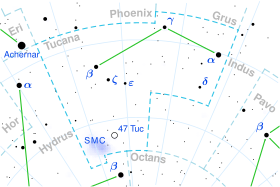Eta Tucanae
| Observation data Epoch J2000 Equinox J2000 | |
|---|---|
| Constellation | Tucana |
| Right ascension | 23h 57m 35.07852s[1] |
| Declination | −64° 17′ 53.6229″[1] |
| Apparent magnitude (V) | +5.00[2] |
| Characteristics | |
| Spectral type | A1V[2] |
| U−B color index | +0.08[3] |
| B−V color index | +0.06[3] |
| Astrometry | |
| Radial velocity (Rv) | +32.50[4] km/s |
| Proper motion ( | RA: +78.850[1] mas/yr Dec.: −62.049[1] mas/yr |
| Parallax ( | 21.2425 ± 0.3639 mas[1] |
| Distance | 154 ± 3 ly (47.1 ± 0.8 pc) |
| Absolute magnitude (MV) | 1.62[5] |
| Details | |
| Mass | 1.94[6] M☉ |
| Radius | 1.8[7] R☉ |
| Luminosity | 23[8] L☉ |
| Surface gravity (log g) | 4.31[9] cgs |
| Temperature | 9,057[8] K |
| Rotational velocity (v sin i) | 190[6] km/s |
| Other designations | |
| Database references | |
| SIMBAD | data |
Eta Tucanae, Latinized from
The radial velocity for Eta Tucanae displays strong oscillations, suggesting this is a spectroscopic binary system. A companion was directly detected in 2014, but this result has some unexplained anomalies.[6] The primary component is an A-type main-sequence star with a stellar classification of A1V.[2] It is spinning rapidly with a projected rotational velocity of 190 km/s,[6] giving it an equatorial bulge that is 15% larger than the polar radius.[11] The star has 1.9[6] times the mass of the Sun and 1.8[7] times the Sun's radius. It is radiating 23[8] times the luminosity of the Sun from its photosphere at an effective temperature of 9,057 K.[8]
References
[edit]- ^ a b c d e Brown, A. G. A.; et al. (Gaia collaboration) (August 2018). "Gaia Data Release 2: Summary of the contents and survey properties". Astronomy & Astrophysics. 616. A1. arXiv:1804.09365. Bibcode:2018A&A...616A...1G. doi:10.1051/0004-6361/201833051. Gaia DR2 record for this source at VizieR.
- ^ a b c d e Ehrenreich, D.; et al. (November 2010), "Deep infrared imaging of close companions to austral A- and F-type stars", Astronomy and Astrophysics, 523: A73, arXiv:1007.0002, Bibcode:2010A&A...523A..73E, doi:10.1051/0004-6361/201014763, S2CID 54913363
- ^ a b Mallama, A. (2014). "Sloan Magnitudes for the Brightest Stars". The Journal of the American Association of Variable Star Observers. 42 (2): 443. Bibcode:2014JAVSO..42..443M.Vizier catalog entry
- ^ a b Kharchenko, N. V.; et al. (2007). "Astrophysical supplements to the ASCC-2.5: Ia. Radial velocities of ~55000 stars and mean radial velocities of 516 Galactic open clusters and associations". Astronomische Nachrichten. 328 (9): 889. arXiv:0705.0878. Bibcode:2007AN....328..889K. doi:10.1002/asna.200710776. S2CID 119323941.
- ^ Anderson, E.; Francis, Ch. (2012). "XHIP: An extended hipparcos compilation". Astronomy Letters. 38 (5): 331. arXiv:1108.4971. Bibcode:2012AstL...38..331A. doi:10.1134/S1063773712050015. S2CID 119257644. Vizier catalog entry
- ^ a b c d e f g Borgniet, S.; Lagrange, A. -M.; Meunier, N.; Galland, F. (March 2017). "Extrasolar planets and brown dwarfs around AF-type stars. IX. The HARPS southern sample". Astronomy & Astrophysics. 599: 26. arXiv:1608.08257. Bibcode:2017A&A...599A..57B. doi:10.1051/0004-6361/201628805. S2CID 118723455. A57.
- ^ a b Allende Prieto, C.; Lambert, D. L. (1999). "Fundamental parameters of nearby stars from the comparison with evolutionary calculations: Masses, radii and effective temperatures". Astronomy and Astrophysics. 352: 555–562. arXiv:astro-ph/9911002. Bibcode:1999A&A...352..555A. Vizier catalog entry
- ^ a b c d Zorec, J.; Royer, F. (2012). "Rotational velocities of A-type stars". Astronomy & Astrophysics. 537: A120. arXiv:1201.2052. Bibcode:2012A&A...537A.120Z. doi:10.1051/0004-6361/201117691. S2CID 55586789. Vizier catalog entry
- ^ David, Trevor J.; Hillenbrand, Lynne A. (2015). "The Ages of Early-Type Stars: Strömgren Photometric Methods Calibrated, Validated, Tested, and Applied to Hosts and Prospective Hosts of Directly Imaged Exoplanets". The Astrophysical Journal. 804 (2): 146. arXiv:1501.03154. Bibcode:2015ApJ...804..146D. doi:10.1088/0004-637X/804/2/146. S2CID 33401607. Vizier catalog entry
- ^ "eta Tuc". SIMBAD. Centre de données astronomiques de Strasbourg. Retrieved 2019-08-28.
{{cite web}}: CS1 maint: postscript (link) - ^ van Belle, Gerard T. (March 2012). "Interferometric observations of rapidly rotating stars". The Astronomy and Astrophysics Review. 20 (1): 51. arXiv:1204.2572. Bibcode:2012A&ARv..20...51V. doi:10.1007/s00159-012-0051-2. S2CID 119273474.

